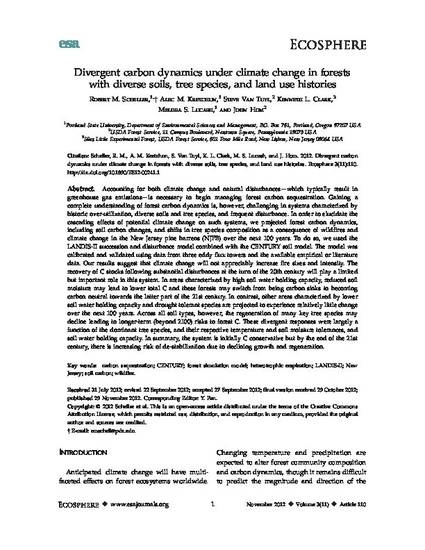
- Forests -- Climatic factors,
- Climatic changes,
- Forest amanagement,
- Carbon sequestration
Accounting for both climate change and natural disturbances—which typically result in greenhouse gas emissions—is necessary to begin managing forest carbon sequestration. Gaining a complete understanding of forest carbon dynamics is, however, challenging in systems characterized by historic over-utilization, diverse soils and tree species, and frequent disturbance. In order to elucidate the cascading effects of potential climate change on such systems, we projected forest carbon dynamics, including soil carbon changes, and shifts in tree species composition as a consequence of wildfires and climate change in the New Jersey pine barrens (NJPB) over the next 100 years. To do so, we used the LANDIS-II succession and disturbance model combined with the CENTURY soil model. The model was calibrated and validated using data from three eddy flux towers and the available empirical or literature data. Our results suggest that climate change will not appreciably increase fire sizes and intensity. The recovery of C stocks following substantial disturbances at the turn of the 20th century will play a limited but important role in this system. In areas characterized by high soil water holding capacity, reduced soil moisture may lead to lower total C and these forests may switch from being carbon sinks to becoming carbon neutral towards the latter part of the 21st century. In contrast, other areas characterized by lower soil water holding capacity and drought tolerant species are projected to experience relatively little change over the next 100 years. Across all soil types, however, the regeneration of many key tree species may decline leading to longer-term (beyond 2100) risks to forest C. These divergent responses were largely a function of the dominant tree species, and their respective temperature and soil moisture tolerances, and soil water holding capacity. In summary, the system is initially C conservative but by the end of the 21st century, there is increasing risk of de-stabilization due to declining growth and regeneration.
Copyright 2012 Scheller et al.
This work is licensed under a Creative Commons Attribution 4.0 International License.
